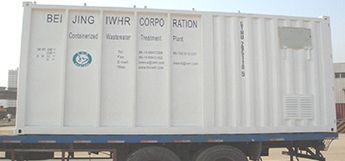Containerized Wastewater Treatment Plant: An Innovative Solution for Sustainable Water Management
Water is one of the most critical natural resources for human existence, and its scarcity and pollution have become significant concerns worldwide. In many parts of the world, untreated wastewater is discharged into the environment, causing severe environmental and health problems. Therefore, it is essential to develop sustainable wastewater management systems that can effectively treat wastewater and reduce its environmental impact. One such solution is the containerized wastewater treatment plant, which is gaining popularity due to its cost-effectiveness, scalability, and ease of installation.
Containerized wastewater treatment plants (CWTPs) are compact, self-contained systems that are designed to treat wastewater from various sources. These systems consist of a series of treatment processes, including primary treatment, secondary treatment, and disinfection. The primary treatment process involves the removal of large solids, grit, and oil and grease from the wastewater. The secondary treatment process uses biological processes to remove dissolved organic matter, nutrients, and pathogens from the wastewater. Finally, the disinfection process kills any remaining pathogens in the wastewater before it is discharged into the environment.
The main advantage of CWTPs is their compact size, which makes them ideal for use in remote areas or areas with limited space. These plants are housed in standard shipping containers, making them easy to transport and install. This means that they can be quickly set up and put into operation, which is particularly important in emergency situations or disaster relief efforts. Furthermore, the modular design of CWTPs makes it easy to scale up or down the treatment capacity as needed, making them a cost-effective option for small and medium-sized communities.
Another advantage of CWTPs is their low environmental impact. These plants use advanced treatment processes that can remove up to 99% of the pollutants from the wastewater. This means that the treated water can be safely discharged into nearby water bodies or reused for non-potable purposes, such as irrigation or industrial processes. Additionally, the modular design of CWTPs allows for the reuse of treated wastewater within the plant, reducing the overall water consumption.
CWTPs also offer significant cost savings compared to traditional wastewater treatment plants. These systems are pre-fabricated and can be manufactured in a controlled environment, reducing the construction costs and the time required for installation. Additionally, the modular design of CWTPs allows for easy maintenance and upgrades, reducing the long-term operating costs.
In conclusion, containerized wastewater treatment plants are an innovative solution for sustainable water management. These systems offer many benefits, including compact size, scalability, low environmental impact, and cost-effectiveness. The modular design of CWTPs makes them ideal for use in remote areas or areas with limited space, and their advanced treatment processes ensure the safe and efficient treatment of wastewater. Therefore, CWTPs should be considered as a viable option for communities, industries, and governments looking to develop sustainable wastewater management systems.


评论
发表评论